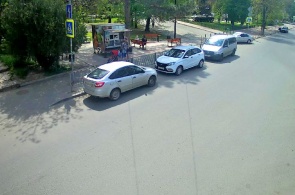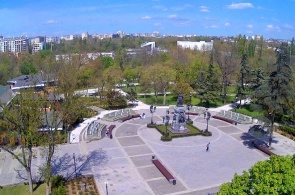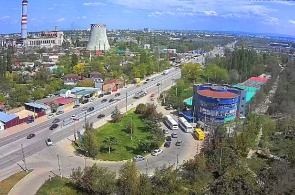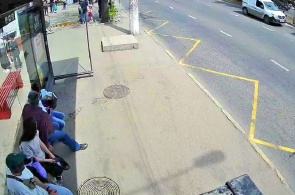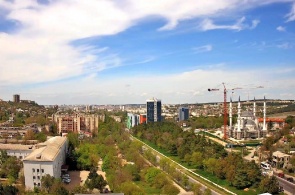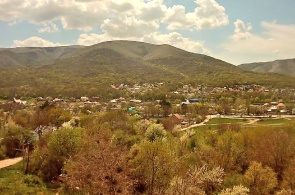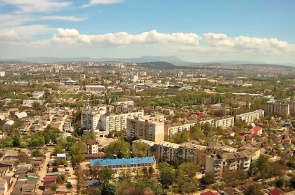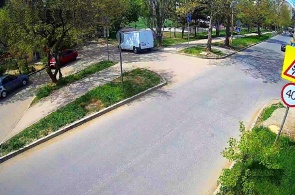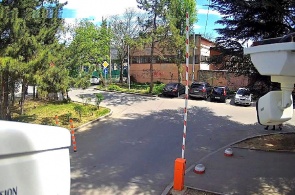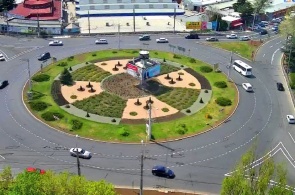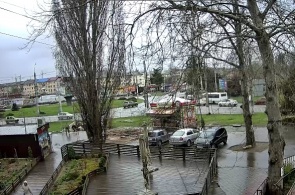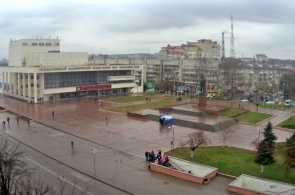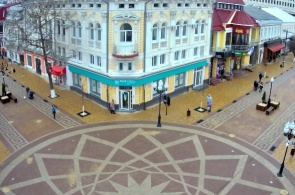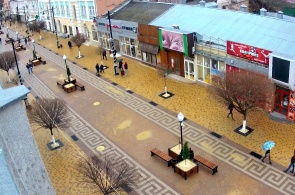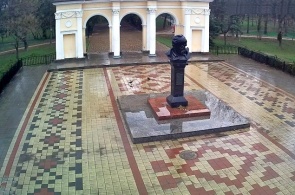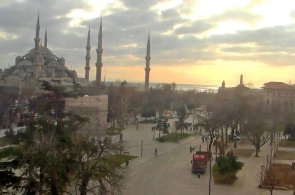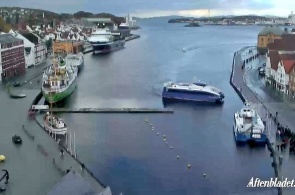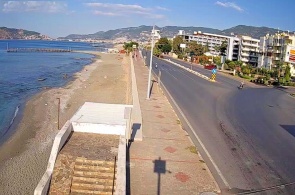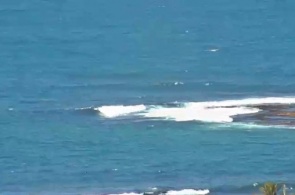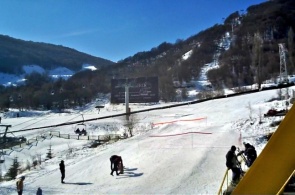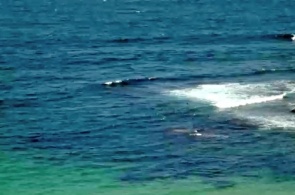Live webcam broadcasts in real time a memorial to the victims of the Nazi occupation of Crimea in 1941-1944 "Red concentration camp". "Krasny" is a state farm near Simferopol, on the territory of which the German-fascist occupation authorities, with the complicity of collaborationists from the local population, organized the largest death camp in Crimea in September 1941.
CONCENTRAL RED - 1941-1944
At the end of October 1941, fascist German troops established a foothold in most of the Crimea and began the transformation of the Crimea into German Gotland. This means that the local population turned out to be superfluous and, at best, the fate of slaves awaited it. As elsewhere in the occupied territories, in the Crimea, the “new order” presupposed the creation of concentration camps. Among the first - in the state farm Krasny near Simferopol.
It was not just a concentration camp, it was an extermination camp, because the main task of the staff of this institution was to destroy as many people as possible in the minimum time with minimum cost and maximum suffering. And they did it diligently.
The prisoners were kept in inhuman conditions, cold, cramped, muddy and daily taken out of the camp for various hard work. On the territory of the camp itself, the inmates built houses, dug a well, or even simply did meaningless work, for example, trying to drive wheelbarrows with stones from one corner to another. They were fed once a day, given a bowl of gourd and a loaf of bread.
But this was not enough for the fascists. People were poisoned in gas chambers, taken to the vicinity of the concentration camp, shot and buried, still not all of the execution sites have been found. After the execution, the bodies, or even living people, were thrown into the wells.
Who are those nonhumans who killed more than 15,000 people in the Red concentration camp near Simferopol? Contrary to popular belief, these are not only Crimean Tatar collaborators from the 152nd Schumanschaft battalion of the auxiliary police of the order - "Schuma", although they were the majority. The trash who came to the Crimea together with the Germans and local renegades of various nationalities and religions also served there.
In April 1944, when our troops were already at Perekop, mass executions began in the Krasnoye concentration camp. More than 2,000 prisoners were killed in a few days. On April 13, Soviet troops liberated Simferopol and the relatives of the prisoners rushed to look for their loved ones. It is impossible to look without tears at the footage of the chronicle with the rows of bodies that were raised from the wells, at people who are looking for relatives among them, and at those who have already found them.
In 1944, not all bodies were raised from the wells. Warmth came and for sanitary reasons the work had to be stopped. But the materials collected by the investigators in 1945 were sent to Nuremberg.
At the Nuremberg trials, materials about the atrocities of the German fascists and their accomplices in Crimea, the massacre of Soviet people, including women and children, in the camp of the Krasny state farm in the Simferopol region became one of the reasons for the conviction of the former commander of the 17th Army, Colonel-General Erwin Jenecke.
CONCENTRAL RED - 1941-1944
At the end of October 1941, fascist German troops established a foothold in most of the Crimea and began the transformation of the Crimea into German Gotland. This means that the local population turned out to be superfluous and, at best, the fate of slaves awaited it. As elsewhere in the occupied territories, in the Crimea, the “new order” presupposed the creation of concentration camps. Among the first - in the state farm Krasny near Simferopol.
It was not just a concentration camp, it was an extermination camp, because the main task of the staff of this institution was to destroy as many people as possible in the minimum time with minimum cost and maximum suffering. And they did it diligently.
The prisoners were kept in inhuman conditions, cold, cramped, muddy and daily taken out of the camp for various hard work. On the territory of the camp itself, the inmates built houses, dug a well, or even simply did meaningless work, for example, trying to drive wheelbarrows with stones from one corner to another. They were fed once a day, given a bowl of gourd and a loaf of bread.
But this was not enough for the fascists. People were poisoned in gas chambers, taken to the vicinity of the concentration camp, shot and buried, still not all of the execution sites have been found. After the execution, the bodies, or even living people, were thrown into the wells.
Who are those nonhumans who killed more than 15,000 people in the Red concentration camp near Simferopol? Contrary to popular belief, these are not only Crimean Tatar collaborators from the 152nd Schumanschaft battalion of the auxiliary police of the order - "Schuma", although they were the majority. The trash who came to the Crimea together with the Germans and local renegades of various nationalities and religions also served there.
In April 1944, when our troops were already at Perekop, mass executions began in the Krasnoye concentration camp. More than 2,000 prisoners were killed in a few days. On April 13, Soviet troops liberated Simferopol and the relatives of the prisoners rushed to look for their loved ones. It is impossible to look without tears at the footage of the chronicle with the rows of bodies that were raised from the wells, at people who are looking for relatives among them, and at those who have already found them.
In 1944, not all bodies were raised from the wells. Warmth came and for sanitary reasons the work had to be stopped. But the materials collected by the investigators in 1945 were sent to Nuremberg.
At the Nuremberg trials, materials about the atrocities of the German fascists and their accomplices in Crimea, the massacre of Soviet people, including women and children, in the camp of the Krasny state farm in the Simferopol region became one of the reasons for the conviction of the former commander of the 17th Army, Colonel-General Erwin Jenecke.
More details
Live webcam broadcasts in real time Mendeleev Street, in the capital of Crimea - Simferopol. In March 1904, this then new street, which arose on the so-called Sultan Meadow, was named Mendeleevskaya. The Duma and the government could not ignore the giant of scientific thought, the creator of the periodic table of elements. Moreover, the great chemist began his career in Simferopol.
Simferopol, Crimea
03.07.21
Live webcam in the Catherine Park of Simferopol, in the foreshortening of this webcam, we can observe the monument to Catherine II. The Catherine Garden is the oldest public park in Simferopol. The first trees were planted on the banks of the Salgir back in 1820, and immediately the magnificent English-style park became a favorite walking place for the townspeople.
Simferopol, Crimea
03.07.21
Live webcam broadcasts in real time a panoramic view of the village of Gresovsky located 8 km from Simferopol on the banks of the Salgir River. Founded on the site of the former village of Zamosc. Among Simferopol residents it is known as the state district power station.
Simferopol, Crimea
27.06.21
Live webcam broadcasts in real time the stop "Cinema Zvezda" in Simferopol. On the site of modern Simferopol, the first people settled in the Paleolithic era, about 50 thousand years ago. On the left bank of the Salgir, in the Chokurcha cave, archaeologists discovered the site of the most ancient people.
Simferopol, Crimea
27.06.21
Live webcam broadcasts in real time the largest mosque in Crimea - the Cathedral Mosque in Simferopol. Today Kebir-Jami is the main Friday cathedral mosque in Simferopol, the residence of the mufti and the Spiritual Administration of Muslims of Crimea. The complex includes a madrasah (educational institution) and a library.
Simferopol, Crimea
27.06.21
The web camera online broadcasts in real time the village of Perevalny, a view of the mountains. The village of Perevalny is located on the Simferopol-Yalta highway, 24 km from Simferopol at the northern foot of the Chatyr-Dag massif. The first name of the village of Angara, in 1945 renamed the Pereval. The first mention dates back to 1864 as a tavern on the river Angara, under the same name.
Simferopol, Crimea
12.06.21
The web camera online broadcasts in real time one of the favorite observation decks of Simferopol residents on the street of Marshal Shchukov. Simferopol is the second largest city in Crimea. It stands on the Salgir River away from the Black Sea coast, so it is impossible to call Simferopol a resort in its purest form. However, there are enough attractions to fill the schedule of any tourist under the knot.
Simferopol, Crimea
12.06.21
Live webcam broadcasts in real time Rostovskaya Street in Simferopol. Simferopol is the capital of Crimea. The name is translated from Greek as "city of the common good" or "guardian city". It is located not on the sea coast, but in the depths of the peninsula. However, this does not take away its charm.
Simferopol, Crimea
08.05.21
Live webcam overlooking Liza Chaikina Street in Simferopol. Elizaveta Ivanovna Chaikina - secretary of the Penovsky underground district committee of the Komsomol of the Kalinin region, one of the organizers of the partisan detachment during the Great Patriotic War. Hero of the Soviet Union. Liza was shot by the Nazis on November 23, 1941. Streets in many cities of Russia and the CIS countries are named after her.
Simferopol, Crimea
08.05.21
Live webcam in Simferopol, overlooking Moscow Square. Along the ring of Moskovskaya square you can go to Kievskaya and Kechkemetskaya streets. Initially, the street was called Perekopskaya, after an active period of development in the 60s of the last century, it was renamed in honor of the great Soviet cosmonaut into Gagarin Street.
Simferopol, Crimea
08.05.21
Web camera in Simferopol, Kirov Avenue with views of the main square of city - Lenin square.
Simferopol, Crimea
02.04.17
Webcam at the intersection of Central streets of Simferopol - Karl Marx and Pushkin.
Simferopol, Crimea
02.04.17
The web camera installed on the pedestrian area of Catherine street (former Karla Marksa) in Simferopol.
Simferopol, Crimea
26.03.17
popular camerasshow all
Sultanahmet or Blue mosque is a work of art of Turkish-Islamic architecture. Its construction began in 1609, the construction work took seven years to a 19-year-old Sultan. The name of the mosque was, due to its interesting and unique finish.
Istanbul, Turkey
08.02.14
Stavanger, a town in the commune of Norway, located in the South-Western part of the country, on the Peninsula, rich in minerals. Tanager combines the influence of foreign organisations such as NATO and oil companies. The camera will shoot the harbour and the promenade of the city.
Stavanger, Norway
03.11.13
A webcam broadcasts the district of Tosmur - quiet location in the Eastern part of Alanya, located only five kilometres from the city centre. Its rural way of life and the beauty of untouched nature attract tourists.
Alanya, Turkey
10.11.18
Shark Island or in English of Shark island, located in the harbour city of Sydney, the suburb of Point Piper. The locals, the natives named the island Boambilly, which translated means Shark island. After all, this name is not casual, because it's mean and looks like a shark fin.
Sydney, Australia
31.10.13
The webcam is installed on site Alva. Tsaghkadzor ski resort town in Armenia. Tsaghkadzor is a beautiful mountainous area among deciduous forests, with a pleasant winter climate, and clean fresh air. The highest point is 1800 meters. The truss type is a classic, divided into three.
Tsakhkadzor, Armenia
18.01.14

